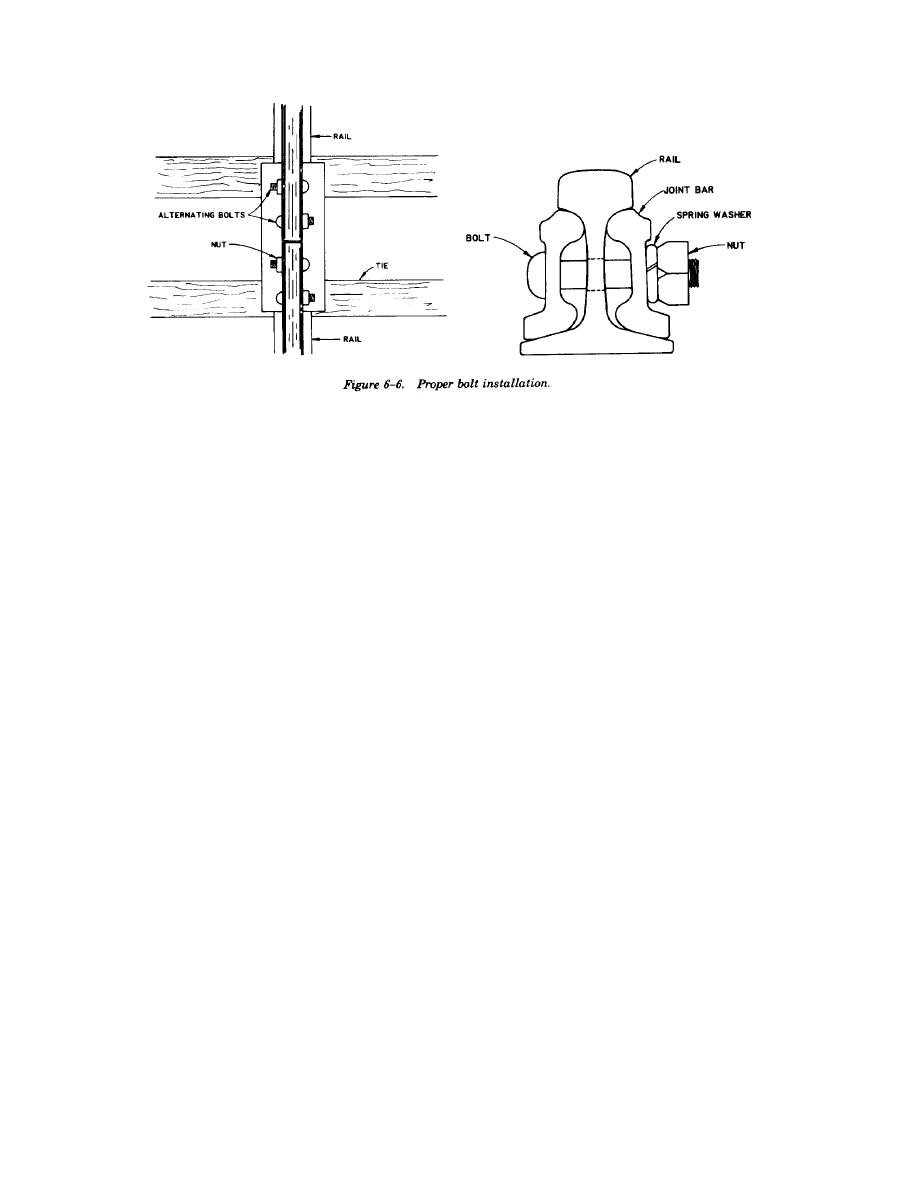
TM 5-628/AFR 91-44
h. Joints in restricted areas. Whenever a joint is
(2) Bolts which cannot be tightened shall be
replaced. Missing bolts shall be replaced.
installed within 20 feet of a road crossing, the outer
(3) Bolts shall be installed with spring lock
perimeter of any structure, or any location which
washers. Nuts shall be installed against the spring
restricts access to the joint, it is recommended that
lock washer as shown in figure 6-6. At least one
the joint be welded.
full bolt thread shall extend past the outside of the
nut.
6-5. Rail anchors.
(4) Bolts shall be installed so that the nuts
a. Rail anchors help prevent the longitudinal
will be alternately on the inside and outside of the
movement of rails commonly known as "running"
rail as shown in figure 6-6.
or "creeping". Rail anchors should be used at loca-
(5) Whenever bolts and joint bars are
tions where the track is subject to serious move-
removed, the rail in the joint area and the contact
ment from rail expansion or traffic conditions.
surfaces of the joint bar shall be cleaned (wire
b. Rules for anchor application. General rules
brushed) and lubrication applied to the joint bar and
on the use of rail anchors are:
the bolt threads. New joint bars and bolts shall be
(1) Anchors shall be applied to the gage side
lubricated before installation.
of the rail against the same tie face on opposite
e. Loose and missing bolts.
rails.
(1) If all bolts at a joint are loose or if there
(2) Anchors shall grip the base of the rail
is only one bolt through each rail, operations shall
firmly and have full bearing against the face of the
not exceed 10 mph.
tie.
(2) Operations shall not be permitted over
(3) When the bearing of the rail anchor
locations where all bolts in one rail are missing.
against the tie has been disturbed by removal of the
f. Rail end mismatch.
tie, the anchor shall be removed and reset.
(1) At any location where rail end mismatch
(4) Anchors shall not be moved by driving
exceeds 3/16] (0.1875) inch on the tread portion or
them along the rail.
gage side of the rail, operations shall not exceed 10
(5) Skewed ties shall be straightened before
mph.
applying rail anchors.
(2) Operations shall not be permitted over
Rail anchors not meeting requirements of para-
locations where the rail end mismatch exceeds
graphs 6-5 a and b should be removed and reset.
(0.25) inch.
c. Anchor locations.
g. Joint gap.
(1) Where used, a minimum of eight
(1) At any location where the gap between
anchors per 39 foot of rail is recommended as
rail ends exceeds 1 (1.00) inch, operations shall not
shown in figure 6-7. Additional anchors should be
exceed 10 mph.
used as needed, and they should be installed four
(2) Operations shall not be permitted over
per tie with approximately uniform spacing along
locations where the gap exceeds 2 inches.
the rail.
6-4


 Previous Page
Previous Page
